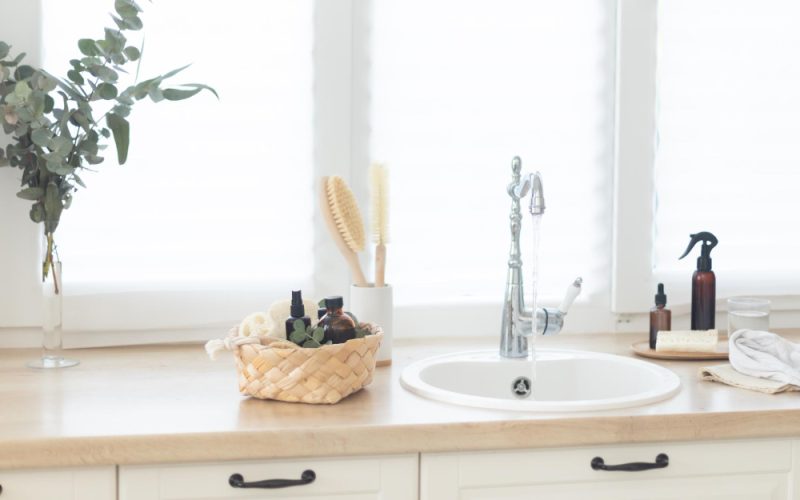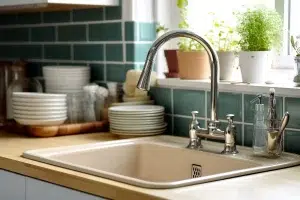Upgrading your bathroom by installing a new vanity can refresh the whole look of the space. However, removing the existing vanity and putting in a replacement takes some work. In a nutshell, the process involves preparation, dismantling the old vanity, installing the new one, and finishing touches.
Dismantling the old vanity comes next, requiring you to disconnect drain pipes and remove countertops and cabinets. Installing the new vanity is essentially reversing this process after careful positioning.
This guide breaks the process down into manageable steps anyone can follow. Let’s start by going over everything you need to do to get ready for vanity removal and replacement.
Table of Contents
TogglePreparation Work – First Step
Replacing a bathroom vanity requires some upfront preparation before you start dismantling the old one. Proper planning makes the installation process smoother. Here are key prep tasks:
- Determine New Vanity Dimensions
Take measurements of the existing vanity and space to help select a suitable replacement model. Standard widths are usually 24”, 30”, 36”, and 48”. Make sure to account for plumbing locations in relation to the new vanity footprint. Consider traffic flow around doors and windows when sizing as well.
- Assemble Materials & Tools
You’ll need basic DIY tools like a pry bar, hammer, screwdriver set, level, tapes measure, etc. Have materials on hand for installing the new vanity like screws brackets, silicone caulk, and sealant. Safety gear like gloves and eye protection are also a good idea.
- Turn Off Water Supply Lines
Locate the shutoff valves below or behind the existing vanity and turn them clockwise to stop water flow. This prevents leaks while you disconnect plumbing. Turn off the supply circuit breaker if removing electrical fixtures too.
- Prep the New Vanity
Inspect your replacement vanity[1] before installation day – are all parts present? Pre-attach mounting brackets to cabinet sides for quicker mounting. Unbox it near the bathroom doorway for easy access.
- Protect Floors & Walls
Lay down drop cloths in the workspace to guard against scratches or water damage during the process. You may also want to remove baseboard trim to simplify installation.
- Work in Sections
Tackling one piece at a time in coordinated stages makes managing a bathroom vanity replacement far less overwhelming. Maintain clear access paths around the workspace at all times.
How to Dismantle Bathroom Vanity?

Here are the steps to dismantle an existing bathroom vanity:
- Disconnect Plumbing Lines
Turn off the hot and cold-water supply valves located under the vanity. Disconnect the drain pipe first – place a bucket underneath to catch water, then loosen the slip nut connecting the pipe to the drain stub in the wall. Detach and remove supply hoses next. Cap all open pipes temporarily.
- Remove Mirror/Medicine Cabinet
Take down any vanity-mounted mirror or medicine cabinet carefully using a pry bar. Insert shims behind to prevent damage as you pop it off the wall. Support the weight as you fully remove screws or adhesive.
- Take Out Backsplash Tiles
Scrape out all the old caulk and grout with a grout saw. Start prying off tiles one by one using a putty knife, working methodically from an edge or corner. Protect the drywall behind to avoid major patching later. Stack tiles neatly for potential reuse.
- Lift Out Sink/Countertop
If the sink and countertop are separate pieces, detach clips, caulk beads, or any hardware like faucets anchoring them together. Carefully lift the bathroom vanity with sink out and detach any remaining drain pieces. For a solid one-piece top, slice through the caulk perimeter with a utility knife before attempting removal.
- Remove Vanity Cabinet
How to remove a bathroom vanity? Take out any drawers or pull-out trays, then locate mounting screws or nails securing the main cabinet to the wall. Remove these mechanical fasteners systematically. Have helpers lift the freed cabinet straight out through the doorway without tipping or twisting to avoid damage.
- Clean Up Workspace
Inspect for any lingering plumbing stubs, wall anchors or tile fragments. Remove remaining caulk and vacuum up all debris. Address any significant drywall damage exposed behind the old vanity. Your bathroom is now prepped and blank for the next vanity coming in.
How To Install Bathroom Vanity?
Here are the key steps involved in installing bathroom vanity:
- Position the Vanity
Carefully carry the new vanity into place, centered on the wall studs. Use shims under the base to level it left to right and front to back. Make sure doors and drawers have clearance.
- Secure the Cabinet
Drill pilot holes through the back panel or side brackets into the wall studs. Attach the cabinet using long screws. Tighten them incrementally to pull it snugly to the wall.
- Hook Up Drain Piping
Connect the vanity sink drain to the drain stub in the wall using a slip nut, adjusting the tailpiece cut length as needed. Confirm fittings are tight enough not to leak but still allow adjustability.
- Connect Water Supply Lines
Attach flexible water supply tubes to the shut off valves and faucet inlets using compression fittings. Make sure to connect hot and cold lines properly on both ends.
- Apply Caulk & Sealant
Run a bead of silicone caulk around the vanity top and base where they meet the wall. Smooth the caulk with a wet finger for a clean finish. Allow to fully cure overnight.
- Turn Water Back On
Reopen the hot and cold water shut off valves. Check under cabinets with flashlights, looking for drips at supply unions, drain slip nuts, etc. Tighten if any seepage is spotted.
- Test & Finish Installation
Turn on the faucet and allow water to run for a few minutes to clear any debris and check for leaks. Add any finishing touches like drawers, mirrors, lighting and backsplash.
Conclusion
Upgrading your bathroom with a new vanity can update the look or gain needed storage space. But installing one properly helps ensure that refreshed appearance and neat organization last for years to come. Follow good preparation, careful removal techniques, expert installation tips, and thorough testing methods
For a smooth, safe DIY vanity replacement backed by professional insight, check out Wangle’s detailed Bathroom Remodeling guides. Their illustrated instructions walk you through key steps while showing pitfalls to avoid.
Frequently Asked Questions – FAQs
Can you install a bathroom vanity yourself?
Yes, with some DIY experience, the right tools, and by following good bathroom cabinet installation guides, many homeowners can tackle a bathroom vanity replacement project on their own. The process involves shutting off water lines, removing the old vanity, putting the new one in place, hooking up plumbing, and finishing.
How to attach a bathroom vanity to a wall?
A bathroom vanity should be securely screwed into the wall framing studs for stability. Locate studs using a stud finder. Hold the vanity in the desired place, mark stud locations on the back panel, then pre-drill holes. Use long, galvanized wood screws through the back brackets into the wall studs.
Should bathroom vanity be screwed to wall?
Yes, screwing through the vanity backing into the wall stud framing provides essential structural support. Relying solely on side brackets or hanging cabinets directly on old screw holes risks the unit gradually loosening over time.




